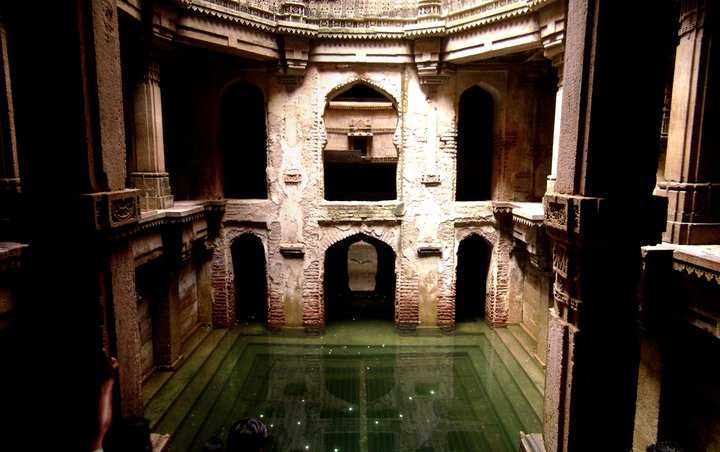
Unique Features of Adalaj Stepwell
The ceiling of the step well has an opening which allows the entry of light and air into the premises of the octagonal structure. However, the construction is such that direct sunlight does not touch the steps or landings except for a brief period at noon. This allows the temperature inside the well to be around six degrees cooler than the outside. Another remarkable feature of Adalaj step well is that out of the step wells in Gujarat, it is the only one with three entrance stairs. These stairs meet at the first storey which has an octagonal opening on top.
History of Adalaj Stepwell
The construction of Adalaj Stepwell was started by Rana Veer Singh, of the Vaghela Dynasty of Dandai Desh in 1498. The decision to build a well was taken very thoughtfully to curb water crisis in Adalaj. At that time, the people of Adalaj would have to walk miles to fetch water for their daily requirements. After the establishment of the structure, Rana Veer Singh was killed in a battle against a Muslim King, Sultan Mahmud Begada who ruled a neighbouring state.
After Rana Veer Singh's death, Sultan Mahmud Begada met his widow, Queen Rudabai. He immediately developed a deep love for her and wished to marry her. When he ordered her to be his wedded wife, Queen Rudabai had no option but to accept his proposal. She, however, put a condition forth to Mahmud Begada that the work of the Stepwell that was started by her late husband should be completed. The Sultan accepted her condition and willingly took efforts to complete the construction of Adalaj Stepwell.
Because of this transition, one can see two different styles of architecture that the structure gracefully adorns. When Adalaj Stepwell was completely built, Queen Rudabai committed suicide by jumping in the well, thus sacrificing her life. The well is therefore famously known as the Rudabai Stepwell.
Architecture of Adalaj Stepwell
The structure is a beautiful amalgamation of two styles of architecture - the Solanki and the Islamic style. The stepwell is five storeys deep and is made entirely of Sandstone. The structure was built along the North-South axis with the entrance from the south. It stands firmly with a traditional trabeated system with an octagonal top built on huge intricately carved pillars. The depth was maintained to access groundwater, and each floor was designed to be spacious and extremely well ventilated and adequately lit. On the first floor, one can also find the marble slab with an inscription in Sanskrit signifying the establishment of the structure.
The topmost part of the Adalaj stepwell is a structure with only engraved beams and pillars and no roof. This allows enough light to enter. There are three staircases that lead to the bottom water level of the stepwell. These staircases extend from the East, West and South directions and they lead to the landing on the northern part of the stepwell. The landing has four small rooms - one in each corner. These rooms have bay windows with sophisticated carvings. The bottom of the well consists of a square step-like structure that descends in the shape of a funnel and reaches a brilliantly chiselled circular well. Each square floor is adorned by beautifully carved pillars, beams and arched openings that spiral from the top to the bottom.
The designs on this architectural monument is a wonderful amalgamation of the Indo-Islamic styles. The traditional floral designs of Islamic origin are seen to be fused brilliantly with the carvings of the Hindu and Jain Gods and Goddesses. These patterns are seen on all the floors. Other than this, there are carvings of a King overlooking his subjects, dancers and musicians performing for spectators, women performing their daily chores and women adorning themselves with traditional ornaments. Some interesting features in the carvings include the depiction of Ami Khumbor which symbolises the pot of water of life, the tree of life - also known as the Kalp Vriksha and the Navagraha or the nine planets.
Water Festival at Adalaj Stepwell
The annual Water Festival in Adalaj-Ni-Vav, held in November is organised to celebrate The World Heritage Week which is an initiative taken by the Tourism Department of Gujarat. The entire Stepwell is gorgeously lit, and various entertainment programs are arranged at the venue.
Best time to visit Adalaj Stepwell
The best time to visit Adalaj Stepwell is from October to March as the well is not full of water and visitors can explore most the floors of the stepwell.
How to Reach Adalaj Stepwell
Local transport such as autorickshaws, buses and cabs are easily available to this destination. One can hire a cab or an auto rickshaw or take a bus ride from Gandhinagar to Adalaj Stepwell.
Top Tourist Places in Gandhinagar
Akshardham Temple
Adalaj Stepwell
Sarita Udyan
Trimandir
Indroda Nature Park
Aalloa Hills Resort Golf Course
All Tourist Places in Gandhinagar
Tips
1. Do wear a hat as the sun is pretty harsh there.2. Carry enough water and keep yourself hydrated.3. Watch your step as you explore the corridors.
Photos of Adalaj Stepwell
Comments on Adalaj Stepwell
Post Your Comment














